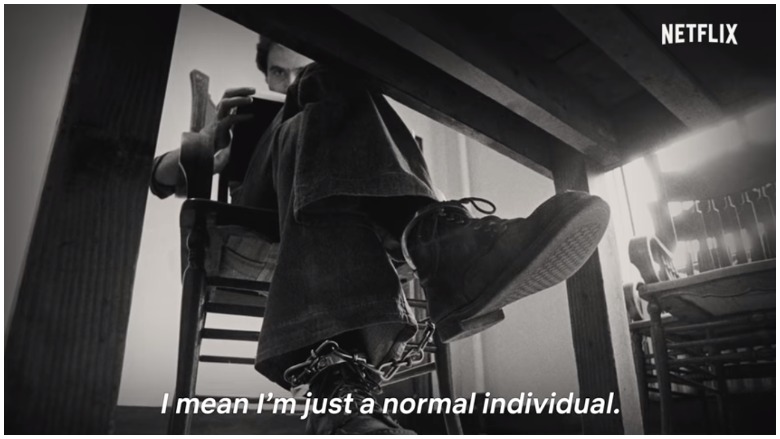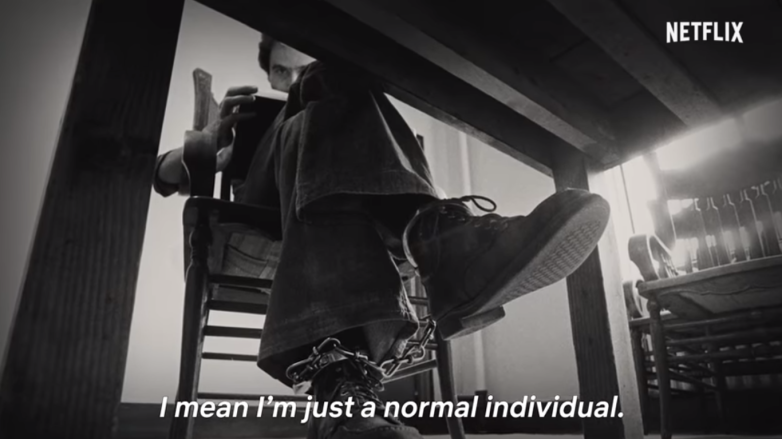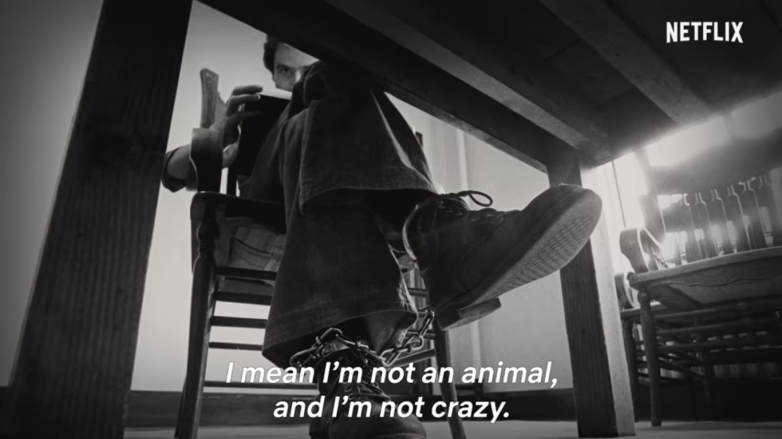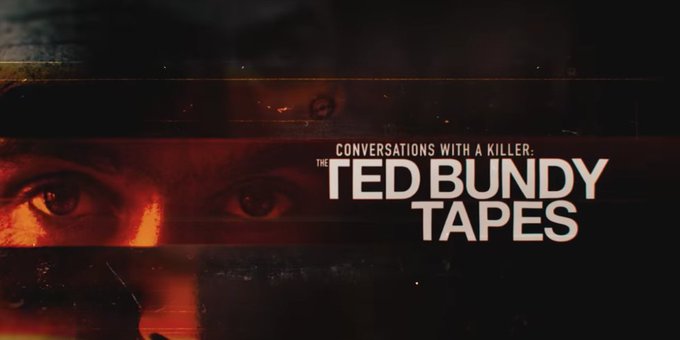
Netflix YouTube screenshot Conversations with a Killer: The Ted Bundy Tapes
Theodore Robert Bundy was born November 24, 1946 in Burlington, Vermont. Strapped into Florida’s notorious electric chair dubbed “Old Spark,” 43 years later, it was reported that when the switch was pulled, and as smoke began to rise from his leg, the serial killer had a smile on his face. This may be an urban legend. What was reported by media at the time was that the night before his execution, he wept and prayed. Outside the prison on US 301 in central Florida 30 years ago to the day, thousands gathered to celebrate and fireworks lit up the sky after it was announced the confessed serial rapist and murderer was dead.
Los Angeles Times reporter Barry Bearak witnessed the execution.
Gone was the storied cockiness. He was ashen as two guards led him into the death chamber to be executed for the 1978 rape and murder of a 12-year-old girl. They strapped his chest and arms and legs to the shiny wooden chair.
Bundy’s eyes searched for familiar faces behind the glass. He nodded to some of the 42 witnesses, including the men who had prosecuted him. His lips moved in a faint mumble.
Then his head bowed. The shaved skull glistened where an ointment had been applied. It would enhance the work of the electrodes.
Nine years before, a journalist interviewed Bundy on Death Row. And it is the recordings of those interviews that is the subject of Netflix’s Conversations with a Killer: The Ted Bundy Tapes. The four-part docuseries begins Jan. 24, 2019, exactly 30 years to the day that the notorious serial killer was electrocuted to his death.
Here’s what you need to know:
1. Bundy Confessed to Killing 30 Young Women & Girls, But May Have Tortured, Raped & Killed 100 or More
Theodore Robert ‘Ted’ Bundy was born November 24, 1946 in Burlington, Vermont. He’d be executed in 1989 as one of the nation’s most prolific and horrifying serial killers.
Ted Bundy confessed to 30 murders. But it’s estimated that he may have tortured, raped and murdered 100. Or more. What is known is that he raped, performed unfathomable deviant sexual torture and murdered young women in Washington, Oregon, Colorado, Utah, and Florida from at least 1974 through 1978.
Bundy was sentenced to death in 1979 for the 1978 rape and murder of two Florida State University college students, Margaret Bowman and Lisa Levy. And was sentenced to death for a separate conviction; the brutal rape and murder of a young girl, 12-year-old Kimberly Diane Leach. After murdering the FSU girls, and brutally sexually assaulting two other sorority sisters, Kathy Kleiner and Karen Chandler, he abducted, raped and killed the child.
Bundy was executed in Florida’s electric chair in 1989.
2. The Docuseries is Based on 150 Hours of Interview Tapes With the ‘Savage Sex Killer.’ Netflix Says it ‘Invades Our Psyche in a Terrifying Way’
Writer Stephen G. Michaud sat with Bundy on Florida’s Death Row for a series of interviews, all taped. The prison, located in Starke, Florida, was then home to the notorious electric chair dubbed ‘Old Sparky.’
In the previously unheard conversations, Bundy tells Michaud that he hadn’t ever “spoken to anybody” about his crimes, but wanted the “opportunity to tell the story as best I can.”
Michaud introduces Bundy as not looking like “anybody’s notion of somebody who would tear apart young girls.”
Michaud’s 1989 book with editor Hugh Aynesworth, ‘Ted Bundy: Conversations with a Killer,’ was described as providing a “unique, horrifying self-portrait of one of the most savage sex killers in history.”

Netflix says its series “brings the infamously twisted mind of serial killer Ted Bundy into the light for the very first time and invades our psyche in a fresh yet terrifying way through exclusive, never-before-heard interviews from the ‘Jack the Ripper of the United States,’ himself.”
Netflix says the series “focuses on a man whose personality, good looks and social graces defied the serial-killer stereotype, allowing him to hide in plain sight as he committed the brutal sex-crime slayings of more than 30 women before being caught in 1978. While on trial, Bundy received extraordinary adoration from American women, which made his gruesome crimes doubly haunting, even in an era of anything-goes mayhem.”
3. Bundy Claimed he Was a ‘Normal Person’ Who Led a ‘Normal Life Except For One Very Small, Very Potent, Very Destructive Segment’
“I grew up in a wonderful home with two dedicated and loving parents …basically, I was a normal person,” Bundy said in his last published video interview.
Stunningly, Bundy referred to himself as a “normal person” who lived a “normal life,” save for a “very small” segment devoted to the torture, rape and murders of girls and young women. In a series of studies, a book from a psychologist who worked with Bundy and an article in Psychology Today, it’s revealed that Bundy was not unlike many “serial killers (who) can present a public persona that appears to be ‘good’ and also nurture a dark side that allows murderous fantasies free reign.”

Utah State Prison psychologist Dr. Al Carlisle evaluated Bundy in 1975 spending 20 hours with the killer, whose crimes then were not fully known.
Carlisle was quoted as saying, that Bundy, like other serial killers “…have painful memories from abuse, disappointment, humiliation, frustration, or being bullied, they have turned to fantasies to comfort themselves. They might even develop an alternate identity that feels more powerful or provides greater status. Bundy had detailed hero fantasies which eventually turned into sexual possession.”
Indeed, as Bundy was recorded admitting, he had a secret “very potent, very destructive” segment of his life. It’s reported he referred to that side as an “entity.”
That entity may have murdered more than 100 girls and women though he confessed to 30 murders three days before his execution.
4. Directed by Oscar & Emmy-Winning Documentarian Joe Berlinger Who Doesn’t Leave the Story Here
Berlinger is an Emmy-winning and Academy Award–nominated true crime documentary filmmaker. On the Sundance website, Berlinger’s work has been described as seeking to “create lasting change through stories of crime, the potential fallibility of the legal system, and the plight of the wrongfully convicted.”
“We’re in this explosion right now of true crime media. People can’t seem to get enough of it. From Serial to Making a Murderer, American viewers seem to have an insatiable appetite for true crime programming,” Berlinger told Newsweek.
Berlinger’s documentaries include Brother’s Keeper, Paradise Lost, and Metallica: Some Kind of Monster.
From Newsweek’s interview with Berlinger:
Bundy was a stepfather with a seemingly classic relationship. He hid his secret need to kill from those around him and behaved as any functioning person in society. Berlinger, who is also releasing a fictional film about Bundy this year, Extremely Wicked, Shockingly Evil and Vile, was allowed to look at photo albums of Bundy and his family, and said the photographs within them looked the same as his own family albums.
Berlinger thinks the allure in Bundy’s story comes from his ability to behave as a normal person. “The thing that I find most fascinating about Bundy is that he taps into our deepest, darkest fear that the person next to us could be a raving lunatic and not to be trusted,” he said. “I think Bundy really encapsulates that more than any other serial killer.”
5. ‘Extremely Wicked, Shockingly Evil and Vile’ Starring Zac Efron as Ted Bundy Premieres at Sundance Film Festival
Premiering at the Sundance Film Festival on Saturday Jan. 26, ‘Extremely Wicked, Shockingly Evil and Vile,’ stars Zac Efron. This is Berlinger’s Bundy act two; he’s the director.
According to IMDb, the film is a “chronicle of the crimes of Ted Bundy, from the perspective of his longtime girlfriend, Elizabeth Kloepfer, who refused to believe the truth about him for years.”

